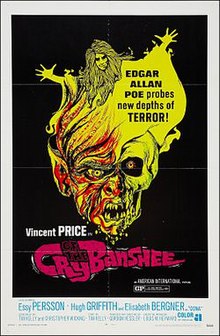| Cry of the Banshee | |
|---|---|
 Theatrical release poster. | |
| Directed by | Gordon Hessler |
| Written by | Tim Kelly Christopher Wicking (screenplay) |
| Produced by | Louis M. Heyward Executive Samuel Z. Arkoff James H. Nicholson Gordon Hessler |
| Starring | Vincent Price Elizabeth Bergner Hilary Dwyer Essy Persson Patrick Mower Sally Geeson Pamela Fairbrother Hugh Griffith |
| Cinematography | John Coquillon |
| Edited by | Oswald Hafenrichter |
| Music by | Les Baxter |
| Distributed by | American International Pictures |
Release date | Jul 29, 1970 (U.S. release) |
Running time | 91 min. |
| Language | English |
| Budget | $450,000-$500,000 (est.)[1] |
| Box office | $1,306,000 (US/ Canada rentals)[2] |
Cry of the Banshee is a 1970 horror film directed by Gordon Hessler, starring Vincent Price as an evil witchhunter. The film was released by American International Pictures. The film co stars Elizabeth Bergner, Hilary Dwyer, and Hugh Griffith. The script by Christopher Wicking and Tim Kelly is loosely based on the story by Edgar Allan Poe, but has nothing to do with the exact story.
The title credit sequence was animated by Terry Gilliam.
Plot
The film is set in Elizabethan England and revolves around a wicked magistrate who tries to kill all the members of a coven of witches.
Lord Charles Whitman is hosting a great feast when suddenly two poor and ragged-looking little children enter the great hall. A burst of wolf-like howling from outside the walls warns that they may be "devil-marked." The lord decides to kill them in spite of the risk. As his shifty eldest son sleeps with his father's pretty young wife and his daughter seeks out her favorite hairy-chested servant for comfort, Lord Whitman begins mumbling that he wants to "clean up" the witches in the area, especially "that decrepit old bag, Oona."
Assisted by his two older sons, Whitman goes hunting in the hills for witches, odd characters, and "persons of interest." His armed posse breaks up what is apparently meant to be a witches' Black Sabbath, but none of the strangely glassy-eyed and zombie-like young people dancing slowly in their underwear seems to have any knowledge of Oona's whereabouts. Whitman gives the order to "torch this place, grease 'em all" and many of Ooona's followers are killed.
This makes the leader of the coven, Oona, extremely angry. To get revenge on the Whitman clan Oona calls up a magical servant, a "sidhe", to destroy the lord's family. Unfortunately, the demonic beast takes possession of the friendly, decent young servant, Roderick, that free-spirited Maureen Whitman has been in love with for years. The servant turned demon begins to systematically kill off members of the Whitman family, until only Lord Whitman and his daughter are left.
Meanwhile, Harry, Whitman's son from Cambridge, and Father Tom find Oona and kill her. Maureen shoots the demon in the head with a blunderbuss, apparently killing him. Exhilarated that the curse is over, Whitman plans to leave the house with his two remaining children by coach. On the way, he stops at the cemetery,so he may have one last gloat at Roderick's corpse. To his horror, he finds the coffin empty, and hurries back to the coach, only to find both Harry and Maureen dead. It is then revealed that Bully-boy, the coaches driver, was murdered by Roderick, who is now driving the coach.
The film ends with Whitman screeching his driver's name in terror, as the coach heads for parts unknown.
The titular "cry of the banshee" is the signal that someone will die.
Trivia
- The film was played at the first Quentin Tarantino Film Festival in 1997 at the Dobie residence hall near the University of Texas.
- Is mentioned in the Rob Zombie song Demonoid Phenomenon, from his 1998 album Hellbilly Deluxe.
- The opening credits were created by Terry Gilliam.
- The film was promoted with a poem that went:
"Who spurs the beast the corpse will ride?
"Who cries the cry that kills?
"When Satan questioned, who replied?
"Whenst blows this wind that chills?
"Who walks amongst these empty graves
"And seeks a place to lie?
"'Tis something God ne'er had planned,
"A thing that ne'er had learned to die."
This verse was spuriously attributed to Edgar Allan Poe.
Production
Gordon Hessler did not like Tim Kelly's original script and hired Chris Wicking to rewrite it.[3] Hessler says he would have gotten Wicking to change it more - including making the witch characters more good - but AIP would not let him. The original music score was done by Wilfrid Joseph but AIP decided not to do it and use a score by Les Baxter instead. Elisabeth Bergner plays a small role; it was her first appearance in a movie in 29 years.[1]
Release
The film was a commercial success but Hessler was dissatisfied with it and calla it the least interesting of the four movies he made for AIP.[1]
Home Video Release
In April 1991, Cry of the Banshee was packaged as a Laserdisc double feature, paired with the first of the Count Yorga movies, Count Yorga, Vampire. Both films were not letterboxed, but employed a full screen, pan-and-scan process.
References
- ^ a b c Tom Weaver, "Gordon Hessler", Return of the B Science Fiction and Horror Heroes: The Mutant Melding of Two Volumes of Classic Interviews 2000 McFarland, p 148
- ^ "Big Rental Films of 1970", Variety, 6 January 1971 p 11
- ^ Mark McGee, Faster and Furiouser: The Revised and Fattened Fable of American International Pictures, McFarland, 1996 p279